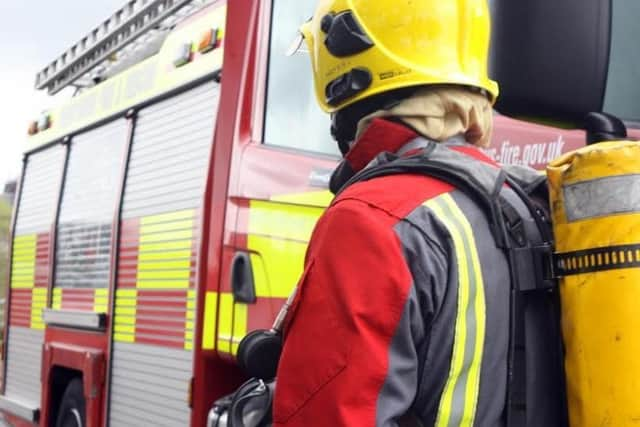Warning of 'hugely negative impact' of wildfires on the environment
and live on Freeview channel 276
Greater Manchester Fire and Rescue Service (GMFRS) is reminding people of the importance of preventing these kinds of incidents and avoiding the devastation and disruption they bring with them.
A typical wildfire can be disastrous for the environment, displacing or destroying wildlife and habitats, damaging peatland for decades and causing countless other environmental hazards, including risks to human health.
Advertisement
Hide AdAdvertisement
Hide AdThe fire service recently launched its first Fire Plan, outlining the work it will do to make Greater Manchester safer.


Its efforts to prevent and mitigate the damage caused by wildfires supports Greater Manchester’s Five-Year Environment Plan, which sets out a vision for protecting and enhancing natural assets and the benefits they provide to communities and the economy.
GMFRS station manager Dave Swallow, who is the deputy wildfire lead with the National Fire Chiefs’ Council, said: “GMFRS is committed to supporting Greater Manchester’s Five-Year Environment Plan and, as outlined in its new Fire Plan, will be refreshing its sustainability strategy to ensure the service is resilient to potential impacts of the climate emergency.
“Wildfires can have a hugely negative impact on the environment and the release of greenhouse gas emissions into the atmosphere is also a contributing factor to climate change. This is why we continue to urge people to take care when visiting the countryside and never be tempted to light barbecues or campfires on the moors.
Advertisement
Hide AdAdvertisement
Hide Ad“We are now approaching the third anniversary of the 2018 moorland fires, which remain fresh in the minds of everyone involved - from our firefighters, who worked incredibly hard to put the fires out, to the residents who were forced from their homes. There is no better time to remind people that the smallest action can have catastrophic consequences, putting people’s safety – and our natural environment – at risk.”
Peatlands, which are often damaged by wildfires – such as those which tore through parts of Greater Manchester and neighbouring areas in summer 2018 – can play a vital role in the fight against climate change, capturing carbon form the atmosphere, reducing flood risk and supporting biodiversity.
The Greater Manchester Peat Pilot, in partnership with Natural England, recently carried out key research into the potential of peat in helping Greater Manchester to become carbon neutral by 2038.
Those involved in the project mapped the size and condition of peatlands across the city-region, including the Winter Hill area of Bolton. The fire on the moors there in June 2018 caused an estimated 25,556 tonnes of carbon to be released into the atmosphere and negated significant conservation work by the Woodland Trust and United Utilities in the area.
Advertisement
Hide AdAdvertisement
Hide AdGreater Manchester’s green city-region lead, Coun Neil Emmott, said: “Greater Manchester’s peatlands are of great importance to our communities and our wildlife, but wildfires pose a grave danger to these vital natural resources.
“In the most recent wildfires in Greater Manchester and the surrounding areas, thousands of tonnes of carbon have been released into our atmosphere. Wildfires not only mean poorer air quality for residents across our city-region, they also result in the kinds of harmful emissions that we have to cut if we want to meet our target of becoming carbon neutral by 2038.
“We know that people here really value our spectacular natural surroundings and want to see our wildlife thrive. Over the past year, conservation teams have worked hard to bring the Manchester argus butterfly back to our city-region’s peat bogs, a large heathland butterfly that had not been seen here in 150 years. With wildfire incidents increasing in both frequency and scale, if things continue at this rate our endangered wildlife will have no where left to go, and may disappear completely.”
The Department for Environment, Food and Rural Affairs highlights several environmental risks which can occur as a result of wildfires. These include harmful chemicals going into water bodies and habitat loss for mammals, reptiles and ground nesting birds.
Advertisement
Hide AdAdvertisement
Hide AdAnother risk is emissions of miniscule particulate matter from smoke into the atmosphere. Inhaling particles that are less then 2.5 microns in diameter has been shown to be damaging to human health.
GMFRS works closely with partners to prevent and further understand wildfires, and is currently leading a survey on behalf of UK fire and rescue services to gather public views about wildfires.
The survey closes on August 31, with results to be used to shape future work around wildfires. It can be found at www.gmconsult.org/strategy-team/public-perception-of-wildfire/
To find out more about staying safe when visiting the countryside, visit GMFRS’ website.
Thanks for reading. If you value what we do and are able to support us, a digital subscription is just £1 for your first month. Try us today by clicking here